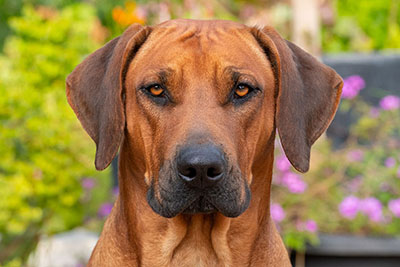The European settlers developed a distinct breed to meet their needs in the African Veldt by selectively breeding between European dogs and the ridged dog of the Hottentot tribes. The breed was developed for hunting wild game, protection of the hunter and his family, and companionship. It needed stamina, endurance, a short coat, and resistance to the wild temperature swings found on the High Veldt. Throughout the breeds development, the ridge of the Hottentot dog was respected and retained, leading to the “Ridgeback” of today.
The only other known dog which has the peculiarity of such a ridge is found on the island of Phu Quoc in the Gulf of Siam. Linkage between this dog and the Rhodesian Ridgeback has never been determined.
There is no doubt that the breed we know today developed in Rhodesia (now Zimbabwe). In 1875, the Rev. Charles Helm, a missionary, undertook a journey from his home in Swellendam in the Cape Province of South Africa to Rhodesia. He was accompanied by two ridged dogs. While the Rev. Helm was in Rhodesia, Cornelius von Rooyen, the big-game hunter and early authority on South African wildlife, borrowed the two dogs to take along on a hunt. Von Rooyen soon concluded that they possessed instinctive hunting qualities and thereupon pioneered the breeding of a pack of the species as hunters of big game for his own use. They were bred on an extensive scale in Rhodesia and were given the name of that country.
The Rhodesian Ridgeback has been described as the Decathlete of the Hound breeds; strong, athletic, big hearted and kind they make a wonderful companion…in the right home.
BREED STANDARD
General Appearance
Handsome, strong, muscular and active dog. Symmetrical in outline, capable of great endurance with fair amount of speed. Mature dog is handsome and upstanding.
Characteristics
A distinctive feature is the ridge on the back formed by hair growing in opposite direction to the remainder of coat. Ridge clearly defined, tapering and symmetrical, starting immediately behind shoulders and continuing to haunch, and containing two identical crowns only, opposite each other, lower edges of crowns not extending further down ridge than one-third of its length. Up to 5 cm (2 ins) is a good average for width of ridge.
Temperament
Dignified, intelligent, aloof with strangers but showing no aggression or shyness.
Head & Skull
Of fair length, skull flat, rather broad between ears, free from wrinkles when in repose. Stop reasonably well defined. Nose black or brown in keeping with colour of dog (black nose accompanied by dark eyes, brown nose by amber eyes). Muzzle long, deep and powerful. Lips clean and close fitting.
Eyes
Set moderately well apart, round, bright and sparkling with intelligent expression, colour harmonising with coat colour.
Ears
Set rather high, medium size, rather wide at base, gradually tapering to a rounded point. Carried close to the head.
Mouth
Jaws strong with a perfect, regular and complete scissor bite ie. upper teeth closely overlapping lower teeth and set square to the jaws. Well developed teeth, especially canines.
Neck
Fairly long, strong and free from throatiness.
Forequarters
Shoulders sloping, clean and muscular. Forelegs perfectly straight, strong, heavy in bone. Elbows close to the body.
Body
Chest not too wide, very deep and capacious; ribs moderately well sprung, never barrel-ribbed. Back powerful, loins strong, muscular and slightly arched.
Hindquarters
Muscles clean, well defined; good turn of stifle, hocks well let down.
Feet
Compact, well arched toes; round, tough, elastic pads, protected by hair between toes and pads.
Tail
Strong at root, not inserted high or low, tapering towards end, free from coarseness. Carried with a slight curve upwards, never curled.
Gait/Movement
Straight forward, free and active.
Coat
Short, dense, sleek and glossy in appearance but neither woolly or silky.
Colour
Light wheaten to red wheaten. Head, body, legs and tail or uniform colour. Little white on chest and toes permissible but excessive white hairs here, on belly or above paws undesirable. Dark muzzle and ears permissible.
Size
DOGS – Minimum 63cm to Maximum 67 cm (25-27 ins) – to withers.
BITCHES – Minimum 61cm to Maximum 66cm (24-26 ins) – to withers.
Faults
Any departure from the foregoing points should be considered a fault and the seriousness with which the fault should be regarded should be in exact proportion to its degree. NOTE – Male animals should have two apparently normal testicles, fully descended into the scrotum.
